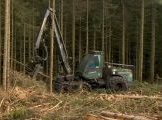An Introduction to Biomass
An Introduction to Biomass
What is Biomass?
Biomass is mostly sourced from commercial forestry, but also comes from the biodegradable fraction of products, wastes and residues from the agricultural industries and waste recycling sectors.
In 2021, it was estimated that 1.491 million tonnes of woodfuel was used for renewable energy generation in Scotland, saving 1.624 million tonnes of CO2e in 2020 (Woodfuel Demand and Usage in Scotland, Energy Savings Trust, 2021).
Find out more about the main forms of wood fuel used in Scotland, including wood chip, pellets and logs here.
Biomass is used to generate electricity (in large grid connected power stations), both electricity and heat (in Combined Heat and Power plants) and heat only plants. It can also be used to produce renewable liquid transport fuels (produced from energy crops like rapeseed).
The Usewoodfuel website focuses primarily on wood fuel used for the generation of heat in commercial scale installations (above 45kW). Heat is Scotland’s largest energy market – more than both transport and electricity generation combined (Annual Compendium of Scottish Energy Statistics, 2020)
You can find out more about the main biomass resources and their associated supply chains and end uses here.
The Benefits of Biomass
The use of biomass is encouraged across the globe, including by the United Nations, the European Union, the UK Government and the Scottish Government. It provides a majority of our renewable energy here at home: and throughout the World. It is most efficiently used to generate heat.
Biomass contributes to local economic development by creating new supply chain jobs and economic activity. It also offers significant carbon emissions reductions, as well as often providing cost savings to those switching from fossil fuels.

Economic Benefits
The ongoing need for fuel creates jobs and ongoing economic benefits.

Reducing Greenhouse Gas Emissions
The facts about wood fuel and emissions.

A Sustainable Fuel
Why wood fuel from Scotland is a sustainable resource.






